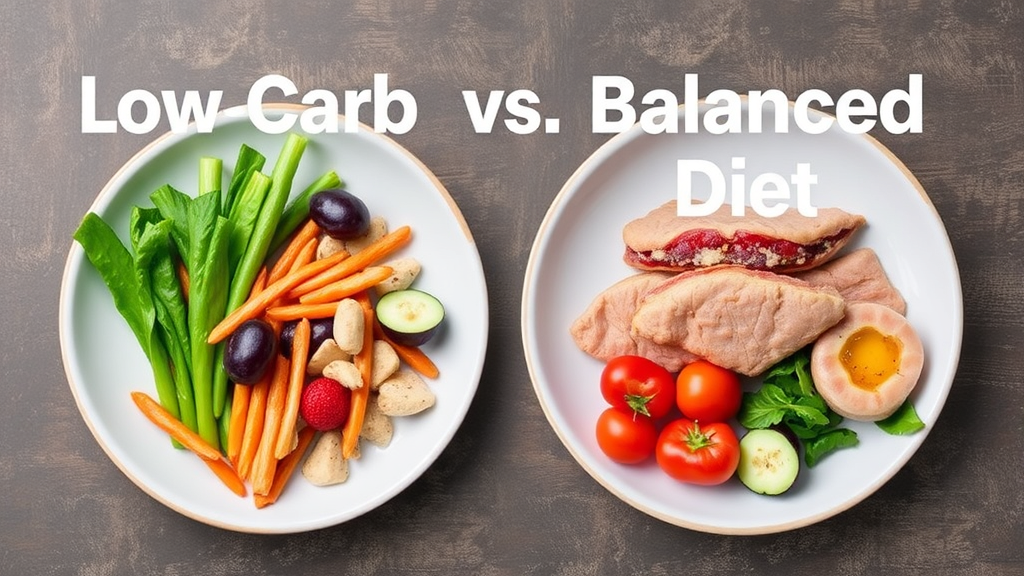Low-Carb vs. Balanced Diet: Understanding the Key Differences
When it comes to diet, the choice between low-carb and balanced diets can be confusing. Many people are looking for effective ways to lose weight, improve their health, and maintain energy levels. Let’s delve into the key differences between these two popular dietary approaches, along with their pros and cons.
Understanding Low-Carb Diets
A low-carb diet typically restricts carbohydrate intake and emphasizes proteins and fats. In this approach, foods high in sugar and starch are minimized, while those rich in proteins, healthy fats, and fiber are encouraged. Some popular versions of low-carb diets include the ketogenic diet, Atkins, and paleo.
- Carbohydrates: Limited to about 20-50 grams per day.
- Protein: Increased intake from sources like meat, fish, and dairy.
- Fats: Encouraged to make up a significant portion of daily calories.
People often choose low-carb diets for benefits like rapid weight loss, improved blood sugar control, and enhanced mental clarity. However, sticking to such a restrictive approach can be challenging and may lead to nutrient deficiencies if not carefully managed.
Exploring Balanced Diets
A balanced diet, on the other hand, includes a variety of foods across all food groups: carbohydrates, proteins, and fats. This approach promotes moderation, ensuring your body gets a wide range of nutrients needed for optimal health.
- Carbohydrates: Comprise about 45-65% of daily caloric intake, focusing on whole grains, fruits, and vegetables.
- Protein: Moderately consumed from diverse sources, including legumes, nuts, meat, and dairy.
- Fats: Kept to about 20-35% of total calories, focusing on healthy fats from fish, nuts, and avocados.
The balanced diet is sustainable, versatile, and easier for many individuals to follow over the long term. This method usually results in stable energy levels and prevents the extreme swings that a restrictive diet may create.
Comparing the Two Diets
| Aspect | Low-Carb Diet | Balanced Diet |
|---|---|---|
| Weight Loss | Rapid initial loss due to water weight. Sustaining can be challenging. | Gradual weight loss is typical; more sustainable long-term. |
| Nutritional Variety | Limited choices may lead to nutrient deficiencies. | Emphasizes variety from all food groups, promoting overall health. |
| Health Benefits | Improved blood sugar control, but may raise cholesterol levels. | Long-term health benefits, including heart health, when followed properly. |
| Ease of Following | Can be difficult to maintain, especially socially. | Flexible and easier to integrate into daily life. |
Which One Is Right for You?
The choice between a low-carb diet and a balanced diet ultimately depends on your preferences, health goals, and lifestyle. If your aim is rapid weight loss and you’re willing to put in the effort to prepare and plan meals carefully, a low-carb approach could work for you. However, if you prefer variety and sustainability, opting for a balanced diet may be the more suitable choice.
It’s essential to listen to your body. Everyone responds differently to dietary changes. Before making significant adjustments to your diet, consider consulting with a healthcare professional or a registered dietitian for personalized guidance. Understanding what works best for your individual health and lifestyle is crucial.
To explore more about these dietary strategies, visit Healthline for detailed insights on low-carb diets and Academy of Nutrition and Dietetics for a comprehensive guide on balanced diets.
Popular Low-Carb Diets: What You Need to Know
Low-carb diets have taken the health and wellness world by storm in recent years. With various options available, understanding the most popular low-carb diets can help you decide which one may suit your lifestyle and health goals. Here are some noteworthy diets that you should consider:
Ketogenic Diet
The ketogenic diet, often called the keto diet, is focused on high-fat, moderate-protein, and very low-carb intake. The goal is to induce a state known as ketosis, where the body burns fat for fuel instead of carbohydrates. This diet typically allows less than 20-50 grams of carbs per day. Some of its benefits include:
- Weight loss and fat loss
- Improved blood sugar control
- Increased mental clarity
However, it’s essential to note that the keto diet may not be suitable for everyone. Long-term adherence can be challenging, and some people experience side effects known as the “keto flu” when starting. For more detailed insights about the keto diet, visit Healthline.
Paleo Diet
The paleo diet focuses on mimicking the eating patterns of our ancestors. It emphasizes whole foods that can be hunted or gathered, such as:
- Lean meats
- Fish
- Fruits
- Vegetables
- Nuts and seeds
While grains, dairy, and processed foods are eliminated, people often find this diet easier to follow. Benefits of the paleo diet include improved weight management and a decreased risk of chronic diseases. To find out more, check out PaleoHacks.
Atkins Diet
Developed by Dr. Robert Atkins, the Atkins diet has four phases that gradually reintroduce carbohydrates after an initial strict low-carb period. This diet focuses on high protein and fat and restricts carbohydrates. The phases are:
| Phase | Description |
|---|---|
| Induction | Limit carbs to 20-25 grams daily for rapid weight loss. |
| Balancing | Add nuts, berries, and other low-carb foods |
| Pre-Maintenance | Gradually increase carb intake while still losing weight. |
| Maintenance | Find a balanced level of carbs to maintain weight. |
The Atkins diet can lead to significant weight loss, but it’s essential to focus on healthy, whole food choices throughout the phases. For more on the Atkins diet, refer to Atkins.
Dukan Diet
The Dukan diet is a high-protein, low-carb plan created by Dr. Pierre Dukan. It has four phases, similar to the Atkins diet:
- Attack Phase: A few days of only protein.
- Cruise Phase: Introduce vegetables.
- Consolidation Phase: Gradually add back fruits and whole grains.
- Stabilization Phase: Maintain weight loss with a balanced diet.
As with other low-carb diets, the Dukan diet is designed for quick weight loss but may also lead to nutritional deficiencies if not carefully monitored. Learn more about the Dukan diet at Dukan Diet.
Clean Low-Carb Diet
This approach emphasizes consuming whole, unprocessed foods while keeping carbs low. It encourages:
- Organic vegetables
- Grass-fed meat
- Wild-caught seafood
- Healthy fats like avocado and olive oil
The clean low-carb diet is sustainable and promotes overall health without strict calorie counting. The focus on quality nutrients enhances satiety and supports hormone balance. For more information on clean eating, explore Clean Plates.
Choosing the right low-carb diet depends on your individual health objectives, lifestyle, and preferences. Exploring these popular diets can guide you toward a decision that aligns best with your needs.
The Science Behind Balanced Diets: Health Benefits and Nutrients
Understanding the fundamentals of a balanced diet is crucial for improving health and well-being. A balanced diet consists of nutrients from various food groups that work together to promote overall health. Let’s explore the core health benefits and essential nutrients that make a balanced diet effective.
Core Health Benefits of a Balanced Diet
A balanced diet has numerous health benefits that can positively impact your life. Here are some of the key advantages:
- Weight Management: Maintaining a balanced diet helps regulate body weight by providing adequate calories and nutrients without excess fat and sugar.
- Improved Energy Levels: Consuming a variety of foods ensures a steady supply of energy throughout the day. Whole grains, fruits, and vegetables serve as excellent fuel sources.
- Enhanced Mood: Research indicates that a balanced diet can improve mood and reduce the risk of mental health disorders. Nutrients like omega-3 fatty acids and vitamins play a vital role in brain health.
- Reduced Risk of Chronic Diseases: Eating a balanced diet rich in fruits, vegetables, and whole grains can lower the risk of heart disease, diabetes, and certain cancers.
- Better Digestive Health: Fiber from whole foods aids digestion and promotes a healthy gut microbiome, reducing the likelihood of constipation and other digestive issues.
Essential Nutrients in a Balanced Diet
A balanced diet includes several essential nutrients that support bodily functions. Here’s a breakdown of these vital components:
| Nutrient | Function | Sources |
|---|---|---|
| Carbohydrates | Primary energy source; important for brain function | Whole grains, fruits, vegetables |
| Proteins | Essential for growth and repair of tissues | Meat, fish, eggs, legumes, nuts |
| Fats | Source of energy; supports cell growth | Olive oil, avocados, fatty fish, nuts |
| Vitamins | Support immune function and overall health | Fruits, vegetables, dairy products |
| Minerals | Important for bone health, nerve function, and muscle contraction | Leafy greens, meat, dairy, whole grains |
| Water | Essential for hydration and all biochemical processes | Water, fruits, vegetables |
A diverse range of foods ensures you are not missing out on essential nutrients. Strive for a colorful plate that includes lots of fruits and vegetables to obtain various vitamins and minerals. For more information on food groups and dietary directions, visit the Choose My Plate website.
Tips for Creating a Balanced Diet
Building a balanced diet can seem overwhelming, but it can be simplified. Follow these tips to get started:
- Plan Your Meals: Take time to schedule your meals weekly to ensure you include a variety of foods.
- Practice Portion Control: Understand serving sizes to prevent overeating and maintain a healthy weight.
- Limit Processed Foods: Try to reduce the intake of processed and sugary foods, opting instead for whole, nutrient-dense options.
- Stay Hydrated: Make sure to drink plenty of water throughout the day.
Consulting a registered dietitian can provide personalized insights tailored to your specific needs and lifestyle. You may wish to explore resources available on the Academy of Nutrition and Dietetics website for professional guidance.
The foundation of good health lies in what you eat. By understanding the importance of a balanced diet and focusing on diverse nutrients, you can make informed choices that lead to a healthier life.
Comparing Weight Loss Results: Low-Carb vs. Balanced Diets
When it comes to weight loss, choosing the right diet plan can often feel overwhelming. Two popular options are low-carb diets and balanced diets. Each has its unique approach to weight loss, and understanding their effectiveness can help you make an informed decision. In this article, we will compare the weight loss results of low-carb versus balanced diets with insights into their benefits and challenges.
Understanding Low-Carb Diets
Low-carb diets limit carbohydrate intake while promoting a high consumption of protein and fats. The most famous versions include the Keto diet and Atkins diet. The main idea behind these diets is to reduce insulin levels, leading the body to burn stored fat for energy.
Here are some potential benefits of low-carb diets:
- Rapid weight loss: Many people experience quick initial weight loss from water weight and decreased appetite.
- Improved metabolic markers: Low-carb diets can enhance cholesterol levels and blood sugar control, which is beneficial for those with diabetes.
- Satiety: High-protein and fat intake can keep you feeling full longer, making it less likely you’ll overeat.
However, there are challenges associated with low-carb diets:
- Restrictive: Limiting carbs can be hard for some, making it difficult to stick with the diet long-term.
- Potential nutrient deficiencies: Cutting out entire food groups may lead to missing essential nutrients.
Exploring Balanced Diets
A balanced diet incorporates a variety of foods, including carbohydrates, proteins, and fats. The key is moderation and ensuring you consume all food groups in a way that meets your body’s needs. This kind of diet emphasizes whole foods like fruits, vegetables, lean proteins, whole grains, and healthy fats.
Benefits of a balanced diet often include:
- Sustainability: This diet is easier to maintain because it doesn’t eliminate food groups.
- Nutrient-rich: You’re less likely to miss out on essential vitamins and minerals, promoting overall health.
- Flexibility: Balanced diets allow for eating out and enjoying social occasions without feeling deprived.
There are some challenges as well:
- Slower weight loss: Since balanced diets can promote moderate calorie intake, weight loss may be less dramatic compared to low-carb diets.
- Requires careful planning: To maintain balance, one must be conscious about portion sizes and food choices.
Comparing Weight Loss Results
Research comparing low-carb and balanced diets shows varying results. Studies indicate that low-carb diets can lead to more significant initial weight loss, especially within the first six months. This can be motivating for many individuals. However, balanced diets have demonstrated effective long-term weight management.
The following table reflects some findings from recent studies comparing the two diet types:
| Study Duration | Weight Loss (Low-Carb) | Weight Loss (Balanced) |
|---|---|---|
| 3 Months | 8-10 lbs | 4-6 lbs |
| 6 Months | 15-20 lbs | 6-10 lbs |
| 12 Months | 10-15 lbs | 8-12 lbs |
While low-carb diets show quick results, many maintain that a balanced diet is more effective for long-term weight maintenance. It promotes a healthier eating habit, which reduces the likelihood of regaining lost weight.
Ultimately, the best choice between a low-carb and a balanced diet depends on your personal preferences and lifestyle. You may find yourself thriving on one type or discover that a combination works best for you. Always consult with a healthcare professional before making significant changes to your dietary routine.
For more information on diet comparisons and personalized nutrition advice, consider checking out Healthline or WebMD.
Long-Term Health Effects: Low-Carb Diets vs. Balanced Eating
The debate between low-carb diets and balanced eating isn’t new, but as we look towards 2025, the long-term health effects of these dietary approaches deserve closer examination. Many individuals are curious about what works best for maintaining health over time, managing weight, and reducing the risk of chronic diseases.
Understanding Low-Carb Diets
Low-carb diets typically focus on reducing carbohydrate intake significantly while increasing protein and fat. This approach can lead to rapid weight loss, which often attracts individuals looking for quick results. However, it’s essential to consider the long-term implications of such drastic dietary adjustments.
- Cognitive Health: Some studies suggest a low-carb diet may improve mental clarity and focus initially. However, over time, the lack of carbohydrates may lead to issues like fatigue and irritability as your brain craves glucose.
- Heart Health: A diet high in saturated fats can increase cholesterol levels in some people. Monitoring cholesterol and overall heart health becomes critical when adopting a low-carb lifestyle.
- Kidney Function: High protein levels may stress the kidneys, especially for individuals with pre-existing kidney conditions.
Balanced Diets and Their Benefits
On the other hand, balanced diets emphasize variety and moderation. These diets typically include carbohydrates, proteins, and fats in a way that provides a holistic approach to nutrition. This approach encourages sustainable eating habits.
- Long-Term Weight Management: A balanced diet often leads to more stable weight control because it doesn’t encourage extreme restrictions, which can lead to binge eating.
- Nutrient Diversity: all food groups ensures that your body receives essential vitamins and minerals, crucial for long-term health.
- Emotional Well-being: Eating a variety of foods can lead to increased satisfaction and enjoyment during meals, reducing feelings of deprivation associated with strict dieting.
Comparative Studies
Research has shown varying results regarding the effectiveness of low-carb diets compared to balanced diets for long-term health. Below is a simplified rundown of findings from recent studies:
| Study | Diet Approach | Key Finding |
|---|---|---|
| Smith et al. (2022) | Low-Carb | Initial weight loss but increased risk of heart disease markers over time. |
| Jones and Lee (2023) | Balanced Diet | Sustained weight maintenance and improved metabolic health. |
| Garcia (2023) | Low-Carb | Positive initial cognitive effects, fading after six months. |
| Chen et al. (2022) | Balanced Diet | Higher satisfaction and reduced likelihood of weight rebound. |
Making Informed Choices
As we move towards 2025, it’s crucial to make informed decisions about dietary approaches. When considering what’s right for you, reflect on your lifestyle, health conditions, and personal preferences. Low-carb diets may work well for some in the short term, but they require careful management to avoid potential long-term health risks. Conversely, a balanced diet offers a sustainable approach that can positively impact your well-being.
Before making any major dietary changes, consider consulting with a healthcare professional or a registered dietitian. They can help identify what might work best given your unique health profile.
For more specific information on dietary health and lifestyle choices, you might find these resources helpful:
Both low-carb and balanced diets have their merits and potential downsides. Understanding the long-term health effects of each can empower you to make educated choices suited to your individual needs, ultimately leading to better health outcomes.
Meal Planning Strategies for Both Diets: Tips for Success
Meal planning can significantly enhance the effectiveness of both low-carb and balanced diets. By being organized, you can save time, reduce food wastage, and make healthier choices. Here are some strategies that cater to both dietary approaches, ensuring you meet your nutritional goals while enjoying a variety of foods.
1. Understand Your Diet Goals
Before diving into meal planning, clarify your goals. Are you aiming for weight loss, maintenance, or improved health? Understanding your motivations will help you choose the right foods. For a low-carb diet, focus on protein and healthy fats. If you’re going for a balanced diet, include a variety of food groups.
2. Create a Weekly Meal Calendar
Setting aside a specific time each week to plan your meals can keep you on track. Follow these steps:
- Choose your planning day: Select a day that allows you ample time to prepare.
- Research recipes: Use websites like Eatwell 101 for healthy meal ideas.
- Allocate meals: Assign each meal to a specific day, ensuring you include snacks.
3. Shop Smart
Making a shopping list based on your meal plan helps you avoid impulse purchases. Follow these shopping tips:
- Stick to the outer aisles: Fresh produce, meats, and dairy often line the edges of the store.
- Limit processed foods: For a low-carb diet, avoid items high in sugar and refined grains.
- Buy in bulk: Consider purchasing proteins and veggies in larger quantities to save money.
4. Prep in Advance
Meal prepping sets you up for success throughout the week. Here’s how:
- Cook in bulk: Prepare large portions of proteins or grains, then portion them out for each meal.
- Pre-chop veggies: Having prepped ingredients on hand makes cooking quick and easy.
- Freeze meals: Consider freezing some meals for days when you’re short on time.
5. Focus on Balanced Plates
When planning meals, aim for balance. Here’s a quick visual guide:
| Food Group | Low-Carb Example | Balanced Diet Example |
|---|---|---|
| Protein | Grilled chicken breast | Salmon fillet |
| Vegetables | Cauliflower rice | Quinoa and mixed bell peppers |
| Fats | Avocado slices | Olive oil dressing |
6. Monitor Portion Sizes
Portion control plays an essential role in managing your calorie intake, regardless of which diet you choose. Here are some strategies to keep in mind:
- Use measuring cups: Initial measurements can help you develop an understanding of portion sizes.
- Visual cues: Use your plate—half for veggies, one quarter for protein, and one quarter for carbs.
7. Stay Flexible
No plan is perfect, and that’s okay! Make adjustments when necessary:
- Substitute ingredients: Swap similar foods if you’re out of something or craving a change.
- Listen to your body: Pay attention to hunger cues and adjust your meals accordingly.
8. Track Your Progress
Monitoring your food intake can reveal what works best for you. Use apps like MyFitnessPal to log meals and track your success.
By implementing these meal planning strategies, you can simplify the process of sticking to either a low-carb or balanced diet. The key is to stay organized, be prepared, and most importantly, be flexible to adapt to your changing needs. With the right planning, you’ll find it easier to maintain a healthy and enjoyable eating pattern.
Personalizing Your Diet: How to Choose the Right Approach for You
Finding the right diet for you can feel overwhelming given the myriad of options available today. It’s essential to realize that personalizing your diet is crucial for long-term success. The approach you choose should cater specifically to your lifestyle, preferences, and health goals. In this guide, we’ll explore how to select the best dietary plan that aligns with your individual needs, helping you thrive.
Assess Your Goals
Start by reflecting on what you want to achieve. Here are some common diet goals:
- Weight loss
- Muscle gain
- Improved heart health
- Enhanced energy levels
- Better digestion
Understanding your goals can greatly influence the diet you choose. Are you looking to shed pounds quickly, or are you aiming for sustainable long-term health improvements? Take some time to write down your goals.
Understand Different Dietary Approaches
Various dietary plans offer unique benefits. Familiarizing yourself with the basics can help you make an informed decision:
- Low-Carb Diet: This approach reduces carbohydrate intake, promoting fat burning. It’s known for weight loss, but may not suit everyone.
- Balanced Diet: A balanced diet includes all food groups, promoting overall nutrition. It can be easier to maintain and is often recommended for long-term health.
- Paleo Diet: This diet focuses on whole foods like meats, fish, fruits, and vegetables, eliminating processed foods.
- Vegetarian or Vegan Diet: These options are based on plant foods and can be healthy if well-planned.
- Intermittent Fasting: Not a diet in the traditional sense, it focuses on when you eat rather than what you eat. This can lead to weight loss and improved metabolic health.
Research each of these options to understand their pros and cons, and see which one resonates with you.
Consider Your Lifestyle and Preferences
Your daily life plays a significant role in your dietary success. Ask yourself:
- What is your cooking skill level?
- Do you have any food allergies or intolerances?
- How much time can you dedicate to meal preparation?
- Do you enjoy dining out often?
These factors will help narrow down your choices. If you love cooking but have a busy schedule, a meal-prep friendly diet might suit you best. Conversely, if you eat out frequently, consider a more flexible approach.
Experiment and Adjust
After choosing a diet, give it some time—typically, a few weeks—to assess how you feel. Monitor your energy levels, mood, and any physical changes. When trying a new eating style, it’s essential to listen to your body.
If you find that a particular diet is either too restrictive or doesn’t align with your health goals, don’t hesitate to make adjustments. Personalizing your diet can mean combining elements from different plans to discover what works best for you.
Seek Professional Guidance
Consulting a registered dietitian or nutritionist can provide personalized insights. They can help tailor a diet plan specific to your needs, taking into account factors like:
- Your current health status
- Any underlying medical conditions
- Your personal tastes and preferences
For assistance, check resources available at Eat Right or The American Society for Nutrition.
Track Progress and Stay Adaptable
Keeping a food diary can be beneficial. It allows you to track what you eat, how you feel, and any changes in your weight or health. Modify your diet as needed, ensuring it remains something you can stick to for the long run.
Be Mindful of Trends
Diet trends may come and go, but it’s essential to focus on sustainability rather than quick fixes. Long-term success usually stems from consistent, healthy choices rather than temporary diets.
Your Dietary Journey
Ultimately, personalizing your diet is a journey. The right approach is one that fits seamlessly into your life while helping you meet your health goals. Embrace the process of discovery, and remember to enjoy the food you eat.
For more information on diet personalization, check out Healthline for up-to-date insights and evidence-based advice.
Key Takeaway:
In the ongoing debate of "Low-Carb vs. Balanced Diet: Which Works Best in 2025?", understanding the nuances between these two dietary approaches is essential for making an informed choice that suits your personal health goals. Here’s a comprehensive key takeaway that encapsulates the critical points from the discussion:
First and foremost, the differences between low-carb and balanced diets hinge primarily on macronutrient distribution. Low-carb diets focus on significantly reducing carbohydrate intake while emphasizing proteins and healthy fats. Conversely, balanced diets advocate for a more even distribution of all macronutrients—carbohydrates, proteins, and fats—ensuring a variety of nutrients that are crucial for holistic health. If you’re someone who enjoys flexibility in meals and prefers diverse foods, a balanced diet may resonate more with you.
Popular low-carb diets, such as the ketogenic and Atkins diets, have captured attention with their promise of quick weight loss and joy from indulging in fats. However, it’s vital to look beyond trends and examine the scientific evidence about their long-term health effects. While many report initial weight loss success on low-carb diets, studies emphasize the importance of sustainability. Balanced diets not only support weight management but also minimize health risks related to nutrient deficiencies.
When evaluating weight loss results, both approaches have shown effectiveness, yet personal factors, including lifestyle and metabolic responses, play a significant role. A low-carb diet may deliver rapid results for some, while others may find a balanced approach more manageable over time.
Effective meal planning is crucial for both diets. Preparing meals in advance can help you maintain your chosen dietary path, making it easier to stay on track and avoid temptation. Strategies might include batch cooking, portion control, and incorporating healthy snacks.
Ultimately, personalizing your diet is key. Understanding your body, preferences, and health goals will help you decide which approach—low-carb or balanced—works best for you in 2025. Remember, the most successful diet is one that you can maintain long-term, foster overall well-being, and enrich your lifestyle. Listening to your body and adjusting your diet as necessary is the most effective strategy in the long run.
Conclusion
Choosing between a low-carb diet and a balanced diet can seem daunting, especially as we move into 2025. Each approach has its unique strengths and potential challenges. Understanding the key differences allows you to weigh the options more effectively. Low-carb diets, like ketogenic and Atkins, can offer quick weight loss results but may not be sustainable for everyone long-term. On the other hand, balanced diets provide a plethora of nutrients, supporting overall health and well-being with more flexibility in food choices.
When it comes to weight loss, individual responses vary. While some people thrive on low-carb plans with rapid progress, others may find success with the gradual, sustainable approach of balanced eating. The long-term health effects also play a crucial role in your decision-making. Balanced diets are generally endorsed for longevity and heart health, whereas low-carb diets require more vigilance to avoid potential nutrient deficiencies.
Meal planning becomes essential for success in either approach. Having a plan makes it easier to stick to your dietary goals, regardless of which path you choose. Remember, personalizing your diet to fit your lifestyle, preferences, and nutritional needs is key. In today’s health-aware environment, listening to your body and adapting your food choices can lead to lasting benefits and overall satisfaction. Ultimately, the best diet is one that you can sustain, supports your health goals, and fits seamlessly into your life.






Leave a Reply